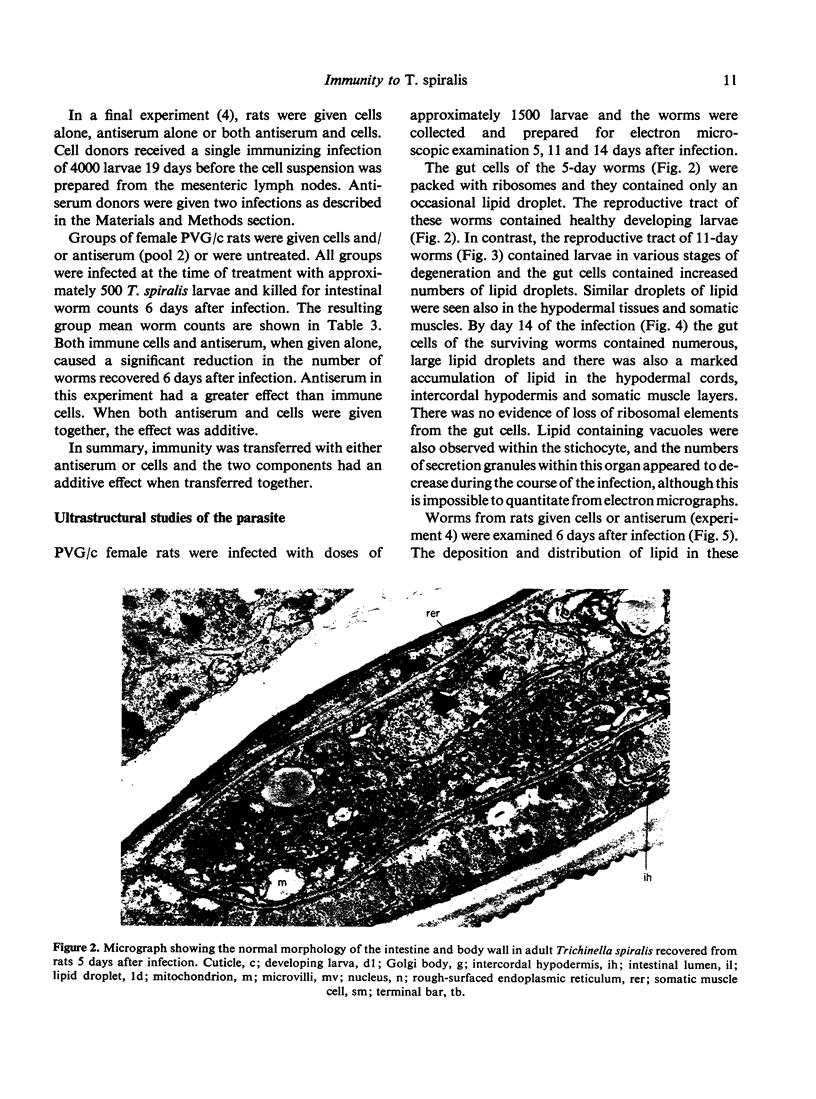Abstract
The immunological response of rats to the intestinal phase of Trichinella spiralis was assessed using criteria derived from pervious studies with the nematode Nippostrongylus brasiliensis in rats and mice. In adult rats, the duration of infection with either parasite is similar and both infections are prolonged in young and lactating rats. As previously shown with N. brasiliensis, immunity to T. spiralis was transferred to recipients with antiserum or mesenteric lymph node cells from immune donors and antisera and cells given in combination had an additive effect. Signs of damage similar to that caused by antibodies in N. brasiliensis appeared in T. spiralis adult worms as the infection progressed and this damage occurred earlier in animals given antiserum or cells. On the basis of these results, it is concluded that the immunological control of adult T. spiralis requires both antibodies and cells, but the relative importance of these components and the way in which they affect T. spiralis requires further analysis.
Full text
PDF








Images in this article
Selected References
These references are in PubMed. This may not be the complete list of references from this article.
- Jones V. E., Ogilvie B. M. Protective immunity to Nippostrongylus brasiliensis: the sequence of events which expels worms from the rat intestine. Immunology. 1971 Apr;20(4):549–561. [PMC free article] [PubMed] [Google Scholar]
- LARSH J. E., Jr EXPERIMENTAL TRICHINIASIS. Adv Parasitol. 1963;1:213–286. doi: 10.1016/s0065-308x(08)60505-9. [DOI] [PubMed] [Google Scholar]
- LARSH J. E., Jr, GOULSON H. T., WEATHERLY N. F. STUDIES ON DELAYED (CELLULAR) HYPERSENSITIVITY IN MICE INFECTED WITH TRICHINELLA SPIRALIS. II. TRANSFER OF PERITONEAL EXUDATE CELLS. J Parasitol. 1964 Aug;50:496–498. [PubMed] [Google Scholar]
- Larsh J. E., Jr Experimental trichiniasis. Adv Parasitol. 1968;6:361–372. doi: 10.1016/s0065-308x(08)60480-7. [DOI] [PubMed] [Google Scholar]
- Larsh J. E., Jr, Race G. J., Goulson H. T., Weatherly N. F. Studies on delayed (cellular) hypersensitivity in mice infected with Trichinella spiralis. 3. Serologic and histopathologic findings in recipients given peritoneal exudate cells. J Parasitol. 1966 Feb;52(1):146–156. [PubMed] [Google Scholar]
- Larsh J. E., Jr The present understanding of the mechanism of immunity to Trichinella spiralis. Am J Trop Med Hyg. 1967 Mar;16(2):123–132. doi: 10.4269/ajtmh.1967.16.123. [DOI] [PubMed] [Google Scholar]
- Love R. J. Nippostrongylus brasiliensis infection in rats. Both antibodies and sensitised cells are necessary for the immunological control of developing larvae. Int Arch Allergy Appl Immunol. 1975;48(2):211–219. [PubMed] [Google Scholar]
- Love R. J., Ogilvie B. M. Nippostrongylus brasiliensis in young rats. Lymphocytes expel larval infections but not adult worms. Clin Exp Immunol. 1975 Jul;21(1):155–162. [PMC free article] [PubMed] [Google Scholar]
- MILLS C. K., KENT N. H. EXERETIONS AND SECRETIONS OF TRICHINELLA SPIRALIS AND THEIR ROLE IN IMMUNITY. Exp Parasitol. 1965 Jun;16:300–310. doi: 10.1016/0014-4894(65)90051-2. [DOI] [PubMed] [Google Scholar]
- McLaren D. J. The anterior glands of adult Necator americanus (Nematoda: Strongyloidea). I. Ultrastructural studies. Int J Parasitol. 1974 Feb;4(1):25–37. doi: 10.1016/0020-7519(74)90006-x. [DOI] [PubMed] [Google Scholar]
- Ogilvie B. M., Hockley D. J. Effects of immunity of Nippostrongylus brasiliensis adult worms: reversible and irreversible changes in infectivity, reproduction, and morphology. J Parasitol. 1968 Dec;54(6):1073–1084. [PubMed] [Google Scholar]
- Ogilvie B. M., Jones V. E. Parasitological review. Nippostrongylus brasiliensis: a review of immunity and host-parasite relationship in the rat. Exp Parasitol. 1971 Feb;29(1):138–177. doi: 10.1016/0014-4894(71)90021-x. [DOI] [PubMed] [Google Scholar]
- Ogilvie B. M., Love R. J. Co-operation between antibodies and cells in immunity to a nematode parasite. Transplant Rev. 1974;19(0):147–169. doi: 10.1111/j.1600-065x.1974.tb00131.x. [DOI] [PubMed] [Google Scholar]






